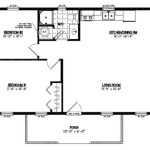How to Draw a Floor Plan of Your House
A floor plan is a scaled diagram that depicts the layout of a space, typically viewed from above. Creating a floor plan of your house can be a valuable tool for various purposes, including home renovation projects, interior design, and even simply understanding the spatial arrangement of your living environment. While professional architects and draftsmen can produce detailed floor plans, it is possible to create a basic yet useful floor plan yourself using readily available tools and a little patience.
1. Gather Necessary Tools and Materials
Before diving into the drawing process, ensure you have the following materials at your disposal:
- Measuring Tape: A reliable measuring tape is essential for accurately recording the dimensions of your house. Choose a tape that is long enough to measure the longest walls in your home.
- Graph Paper: Graph paper provides a grid system that aids in drawing to scale and maintaining proportions. Opt for a grid size appropriate for the scale of your floor plan.
- Pencils and Eraser: Use pencils for initial sketching and erasing mistakes. A sharp pencil will allow for precise lines.
- Ruler: A ruler with clear markings will help draw straight lines and measure distances accurately.
- Protractor: A protractor is useful for measuring angles, especially when dealing with rooms that are not rectangular.
- Color Pencils or Markers (Optional): Colored pencils or markers can be used to differentiate walls, furniture, or other features on your floor plan.
2. Determine the Scale and Set Up the Grid
The scale of your floor plan determines the ratio between the actual dimensions of your house and their representation on the paper. Choosing an appropriate scale is crucial for maintaining accuracy and readability. A common scale for floor plans is 1:50, meaning every 1 centimeter on the paper represents 50 centimeters in real life.
Once you have chosen a scale, use your ruler to divide the graph paper into equal units that correspond to the chosen scale. For example, if your scale is 1:50, each square on the graph paper might represent 1 meter in your house. This grid will serve as a guide for drawing the floor plan.
3. Measure and Record Dimensions
With your measuring tape, carefully measure the length and width of each room, hallway, and other significant spaces in your house. Record these measurements in a notebook or on a separate sheet of paper. It is also advisable to measure and record the position of doors, windows, and any other architectural features.
To avoid confusion, label each measurement with a clear identifier, such as "Room 1 Length" or "Window 2 Width." You can also incorporate a simple diagram or sketch alongside the measurements, which will help you visualize the spatial relationships while drawing the floor plan.
4. Draw the Walls and Outline of Each Room
Using your ruler, carefully draw the walls of each room on the graph paper, ensuring they are drawn to scale. Start by drawing the exterior walls of your house. Use the measurements you recorded to accurately represent the length and width of each room. Connect the corners of the walls with straight lines.
For rooms with irregular shapes, you will need to use your protractor to measure the angles of the walls. Note that you might need to adjust the measurements slightly to accommodate for the scale of your floor plan. Once you have drawn the outline of each room, you can start adding details like doors and windows. Remember to mark their positions based on your measurements.
5. Incorporate Doors, Windows, and Other Features
Use appropriate symbols to represent doors and windows on your floor plan. A simple rectangle with a slight arc at the bottom often signifies a door, while a rectangle with a small square inside can represent a window. Pay attention to the actual dimensions of these features and ensure they are scaled correctly on your drawing.
Other features that might be included in a floor plan can be furniture, appliances, and built-in cabinets. You can use simple shapes to represent these objects, such as circles for round tables, rectangles for sofas, and squares for refrigerators. Again, ensure that these symbols are drawn to scale and maintain the proportion of the actual objects.
6. Add Labels and Annotations
To make your floor plan more informative and user-friendly, label each room with its name or function. Use a clear font that is easily legible. You can also include notes about specific features, such as the type of flooring, the size of appliances, or details about plumbing and electrical fixtures.
Consider adding a legend that explains the symbols used on your floor plan. This will help anyone who views your plan understand the different elements and their meaning. Additionally, a north arrow indicating the orientation of the plan can be beneficial for spatial awareness.
7. Refine and Finalize the Floor Plan
Once you have drawn the basic outline of your floor plan and included all the necessary features, take some time to review your work and make any necessary adjustments. Ensure that the dimensions are accurate and the symbols used are clear and consistent. You can use your eraser to correct any mistakes or refine the lines of your drawing.
You can also use colored pencils or markers to add details and distinguish different areas of your house. For example, you might use different colors to represent bedrooms, bathrooms, and living areas. Take pride in your work and make sure your floor plan is visually appealing and easy to understand.

Floor Plans Learn How To Design And Plan

How To Draw A Floor Plan Dummies

How To Draw A Floor Plan The Simple 7 Step Guide For 2024

Floor Plan Creator And Designer Free Easy App

Make Your Own Blueprint How To Draw Floor Plans

How To Draw House Plans Floor

How To Draw A Floor Plan As Beginner Edrawmax

Floor Plans Learn How To Design And Plan

Make Your Own Blueprint How To Draw Floor Plans Drawing House Sketch Plan

Draw Floor Plans With The Roomsketcher App
Related Posts








